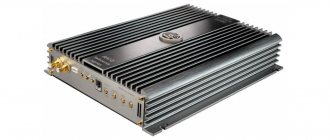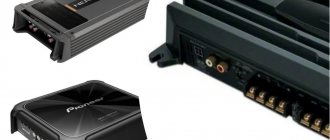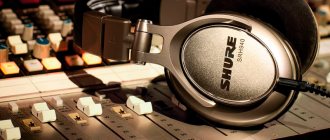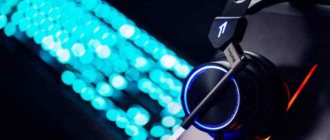Updated: 02/24/2021 18:34:00
Expert: Bogdan Shevchuk
*Review of the best according to the editors of expertology.ru. About the selection criteria. This material is subjective in nature, does not constitute advertising and does not serve as a purchase guide. Before purchasing, consultation with a specialist is required.
The rich variety in the retail sale of a wide variety of headphones, with the complete absence of even a hint of shortage, limits the consumer’s choice only to the cost of each specific model. But when purchasing even the highest quality and most expensive headphones, we may not suspect that they cannot fully reveal their full potential on every device. Often, in order to hear all the richness of a musical composition, headphones need to be “helped” through a special device - an amplifier. This is especially true for headphones with high resistance (impedance).
The Expertology editors, based on the results of market research by our subject matter experts, have prepared for you a brief overview of the most interesting and noteworthy amplifiers as of the beginning of 2022.
How to choose a headphone amplifier
First, let's clarify the most important points that should be taken into account when choosing a headphone amplifier.
The main task of any headphone amplifier is, in fact, to amplify the signal without introducing additional “accidental” or “intentional” distortion into it. That is, to give the opportunity to hear everything that was originally contained in the track being listened to. Everything else - surround sound, emphasizing highs or lows, creating a scene, noise suppression - all these are bonuses that may not even always be appropriate.
The ability of an amplifier, in combination with a specific model of headphones, to transmit sound as it should be “as intended,” or to embellish it in various ways, is characterized by a number of indicators.
Amplifier class
The most general characteristic that makes it possible to quickly narrow the search field. There are two established approaches here. More or less objective - division into classes A, B, AB, C, D and others; and purely marketing - division into Hi Fi and Hi End classes.
It is conventionally accepted that Hi Fi is the basic level of truly high-quality sound, and Hi End is the highest level. In fact, there is no objective and, especially, documentary basis behind this classification. Therefore, if we strongly generalize, we can say that Hi Fi solutions are for the most part quite good and at a reasonable price, while Hi End solutions are often overrated in all respects, and their real advantages are too subtle, and only highly specialized specialists can appreciate them.
As for the letter classification, here the situation is more transparent. Class A amplifiers are truly capable of delivering the best sound quality. But they do this to the detriment of the amplification itself, since they have a relatively low efficiency of 15-30%. They also have the most pronounced side effects in the form of strong heating, gluttony in terms of energy consumption and the highest upper limit in terms of weight - the mass can be tens of kilograms.
Classes B, AB and C are compromise solutions that maintain a balance between efficiency and acceptable distortion. Class D amplifiers are digital, whereas the previous ones are analog. The difference is more or less obvious - analog amplifiers “try” to convey the sound of the track “as is”, that is, as it is, without embellishment and distortion, while the digital D-class is more inclined to simulate good sound, transmitting at the output an excellent-sounding, but actually a completely different audio material.
Combining amplifier parameters with headphone characteristics
Finally, the main criterion for choosing an amplifier is the compatibility of its characteristics with the characteristics of the headphones themselves, with which it will work. The amplifier must be selected for a specific model of headphones or, at least, for a certain range.
The main indicator here is consistency in power and resistance. A self-respecting manufacturer will clearly indicate this parameter in the product description. The most “demanded” combination by most consumers is 120-200 mW per channel at a given resistance with distortion of no more than 0.01%. So, for example, if the manufacturer specifies a power per channel of 180 mW at a resistance of 250 Ohms, this means that the amplifier will easily drive headphones with an impedance of 250 Ohms or even more, providing not only impressive volume, but also decent quality.
In any case, the most important thing is that the minimum operating impedance of the amplifier is at least equal to, or better yet, lower than the impedance of the headphones.
The listed criteria are the most important, those that really influence the result. Other characteristics, such as frequency range and so on, are more auxiliary and are rarely of fundamental importance for the mass consumer.
Top 9. OPPO HA-2SE
Rating (2021): 4.40
The most beautiful This amplifier comes in a leather case, making it look stylish and presentable. There is no shame in putting it on the table.
- Characteristics
Average price: 28,000 rub.
- Country: China
- Power: 0.22W
- Dynamic range: 115 dB
- DAC: yes, 384 kHz/32 bit
- Harmonic distortion: unknown
- Battery life: 13 hours
- Dimensions and weight: 137x68x12 mm, 175 g
The headphone amplifier has a built-in two-channel DAC that is capable of processing PCM signals at the highest quality (up to 380 KHz/32 bit), producing a powerful sound output that opens up all facets of music. The device is equipped with a large number of connectors, which indicates its incredible ergonomics. Two 3.5 ports Line Out and Line In allow the user to independently choose the sound quality - when connected to the first, the DAC capabilities are not used, the music sounds without any processing, and using the second input you can pump up any track and feel the full power of the converter. The case also contains a microUSB connector (for Android devices) and a full-size USB port (for a flash drive, PC or Lightning cable).
Advantages and disadvantages
- Stylish appearance
- Compact dimensions
- Power bank function
- There is a musical color
- Over time, the volume control becomes loose
Rating of the best headphone amplifiers
| Nomination | place | Name of product | price |
| The best stationary headphone amplifiers | 1 | Fiio Olympus 2-E10K | 5 380 ₽ |
| 2 | Sennheiser GSX 1000 | 13 990 ₽ | |
| 3 | Fostex HP-A3 | 19 790 ₽ | |
| 4 | Burson Audio Soloist SL MK2 | 47 920 ₽ | |
| The Best Portable Headphone Amplifiers | 1 | Fiio BTR3 | 4 590 ₽ |
| 2 | Fiio Q1 Mark II | 7 900 ₽ | |
| 3 | OPPO HA-2 | 24 990 ₽ | |
| 4 | Chord Mojo | 35 000 ₽ |
Top 4. Sony PHA3
Rating (2021): 4.60
Best for Sony Headphones An amplifier that works best in conjunction with Sony's flagship headphones, such as the MDR-Z7. It brings out the full potential of the headphones.
- Characteristics
Average price: 34990 rub.
- Country: Japan
- Power: 0.1 W
- Dynamic range: 115 dB
- DAC: yes, 384 kHz/32 bit
- Harmonic distortion: 0.01%
- Battery life: 5 hours
- Dimensions and weight: 140x80x29 mm, 230 g
It's almost a portable DAC and headphone amplifier in one package. The model was released in 2022 and is still relevant - it can work with balanced headphones, in which both channels are connected separately. The delivery set is surprisingly rich, and this partly explains the high cost of the product. In the box, in addition to the amplifier itself, there will be cables for Walkamp and speaker with two 3.5 mm connectors, rubber rings and gaskets, as well as micro-USB for connecting to a smartphone. The sound of PHA-3 is detailed and without pronounced accents - it is neutral. With Sony headphones, this model reveals itself especially well.
Advantages and disadvantages
- Metal body
- Rich equipment
- Lots of entrances
- High price
- Low battery life (5 hours)
- Takes a long time to charge (about 15 hours)
The Best Portable Headphone Amplifiers
The second selection in the review of the best headphone amplifiers presents not just miniature models, but truly portable ones that can be used for high-quality audio listening literally on the go. The unifying characteristics are the presence of a built-in battery and optimal compatibility, for the most part, with not too “heavy” headphones. Otherwise, the presented models are no worse than the stationary ones described above and are in no way cheaper.
Fiio BTR3
Rating: 4.8
Let's start with the most affordable model in this selection, produced by a young but reputable Chinese company already familiar to us, headquartered in Guangzhou. This is a multifunctional device with a built-in DAC and a number of additional features typical of wearable gadgets. It is one of the top-selling portable headphone amplifiers as of late 2022, early 2022.
Dimensions Fiio BTR3 pocket - 25x58x10mm, weight - 26g. The design is laconic, but quite presentable. The body is deep black, rounded corners. The body is made of glass and metal; there are no questions about the assembly and quality of materials. The high level and class is visible in everything, including the packaging, holographic artifacts and even the erasable authentication layer. Easily attaches to clothing using a large clip along the entire back side.
Technically, the device is optimally designed for in-ear headphones with low impedance: power distribution is 0.033 W at 16 Ohm and 0.025 W at 32 Ohm. Harmonic distortion coefficient - 0.003%. The signal to noise ratio is 120dB. Channel distribution - 75dB.
This model has an unspoken priority in interacting with a sound source via Bluetooth4.2 on the CSR8675 chip. Built-in support for many important and minor codecs for wireless audio transmission, including the most important one - AptX HD (others - AAC, LDAC, HWA, etc.). Actually, the conversion of numbers into sound is carried out by the AK4376A discrete DAC. There is also a built-in microphone with noise reduction function, but it is very mediocre.
In addition to Bluetooth, there is another element of wireless technology - the NFC module. The controls are located on the left side of the body. Fiio BTR3 has its own volume control located there. There are only two interfaces – USB Type C and a standard 3.5mm MiniJack for connecting headphones.
The miniature device is powered by a built-in lithium battery with a capacity of 300 mAh. A full charge lasts for 10-11 hours of continuous operation. The amplifier can simultaneously operate and charge via USB or, alternatively, connect to the sound source not wirelessly, but via the same standard USB cable.
Advantages
- high-quality sound;
- impeccable technical performance;
- reliability and reliability;
- Bluetooth;
- NFC;
- autonomy.
Flaws
- ergonomic shortcomings (close proximity of USB and MiniJack, difficult to operate blindly);
- blocks the smartphone microphone.
Top 10. Fiio Q1 Mark II
Rating (2021): 4.25
44 reviews from resources taken into account: Yandex.Market, DNS
Best value for money A high-quality and functional amplifier that perfectly reveals the headphones when the sound source is a smartphone. It has been working for years without failure and has already earned the title of the best model in terms of price and quality ratio.
- Characteristics
Average price: 9490 rub.
- Country: China
- Power: 0.22W
- Dynamic range: 115 dB
- DAC: yes, 384 kHz/32 bit
- Harmonic distortion: 0.001%
- Battery life: 20 hours
- Dimensions and weight: 99x59x12.5 mm, 101.5 g
An inexpensive headphone amplifier with a DAC and the ability to connect to an iPhone without adapters - a Lightning cable is included. The manufacturer has made this model easy to use with a smartphone: the device is compact and lightweight. The upper frequencies are colored, so the presentation cannot be called completely natural. The mids sound as natural and pronounced as possible. You can adjust the bass and gain. Please note that in conjunction with a PC, this amplifier will not provide a significant increase in volume and sound quality, but with a smartphone, due to the DAC, the progress will be clearly pronounced.
Advantages and disadvantages
- Inexpensive
- Convenient sizes
- Cable for connecting to iPhone included
- No battery level indicator
- Tight micro-USB connector
Purpose and features
The store sells thousands of audio amplifiers, and each one is different in both size and purpose. Some are used for non-professional headphones, which are more often used by ordinary users, their voltage is from 0.5 V. The second group is intended for use in professional studios, where full-size devices are used, whose output voltage exceeds 2 V.
Headphones used in smartphones are designed to adhere to the golden mean in order to maintain average-quality sound without using up the entire battery charge. In external amplifiers, the main parameter is to ensure the best quality of the sound signal and that’s it.
When producing mobile phones, companies try to equip them with parts with minimal power consumption in order to achieve maximum autonomy. Therefore, one can only dream of a high-quality microcircuit that will amplify sound. The manufacturer is trying to invest in the minimum budget and maximum autonomy. For this reason, smartphone owners receive sound that is far from ideal, and if most do not distinguish this, then for people who constantly work with music, the difference is obvious.
Often, to achieve good sound on a smartphone, PC or laptop, you buy an external amplifier. It is connected to a standard 3.5 mm jack, and the headphones use the amplifier jack. Such models are equipped with small dimensions, which allows them to be easily moved in a pocket or backpack. It is important to know that the supported headphones depend on the dimensions, i.e. For small vacuum plugs, compact amplifiers are used, for full-size ones, larger amplifiers are used.
In addition to high sound quality, the sound amplifier increases battery life, because it practically does not consume current from the smartphone, but consumes its own battery.
For people who play music at home, buying a stationary amplifier will be a useful purchase. It is powered from a 220 V network, but the use of such a unit is limited and it is not possible to take it with you on a trip.
The meaning of individual technical parameters
Any electrical appliance is characterized by power, which naturally depends on the resistance value. For acoustic speakers, the manufacturer always indicates the maximum power. Knowing that the resistance value of the speakers is 4.8 ohms, it is easy to calculate the volume that they can reproduce. Unlike speakers, headphones have several power ratings for different impedances (8-600 Ohms), and manufacturers do not provide information about the power for each rating. It turns out that the easiest way to adjust the amplifier and headphones is to adjust the level of the supplied voltage corresponding to the load.
Remembering the current formula I=U/R, known since the time of studying a physics course at school, where the letter U denotes voltage and R resistance, you understand that the greater the resistance value, the less current will be, and the less resistance, the greater the force current required. This explains that high-impedance headphones require low current, while low-impedance headphones require high current.
By informing consumers of the level of maximum output current and voltage, the manufacturer of a headphone amplifier thereby seeks to reduce the risk of its poor-quality operation, since if during the setup process the volume is set to an extremely high level, the amplifier may not have enough voltage or current, which will lead to unpleasant distortions in the resulting sound. . Some amplifier models are equipped with two headphone outputs, high-impedance and low-impedance .
Some headphone users are perplexed: why can’t you use a speaker amplifier instead of a headphone amplifier? The answer is simple: they are designed to reproduce a high-level audio signal. Therefore, at low sound levels, listening is interfered with by background noise produced by the amplifier, or a lot of distortion appears at the input to the headphones, which reduces the sound quality.
Types of amplifiers
To help you choose the best amplifier, we suggest considering a brief overview of the existing types.
Amplifiers are:
- Digital.
- Analog.
In smartphones, tablets and computers, audio signals are encoded into ones and zeroes. Digital-to-analog converters are needed to decipher a sequence of numbers and transform them back into sound.
There are amplifiers with good digital-to-analog converters. In many devices, the built-in converters do not have modern enough chips to ensure that the file reproduces the original sound when played.
Analog amplifiers, without electronics, are divided into:
- Transistor;
- Lamp;
- Hybrid.
Among lovers of warm sound with thermal noise, tube types of headphone amplifiers are still popular. They are comfortable to use at home and create an interesting atmosphere.
However, they become very hot, as a result of which they can pose a danger to children and flammable environments. They cannot be used on the road or while walking - their cost is high, and the lamps break easily. Transistor amplifiers work effectively with low-impedance headphones. They are not demanding and energy consumption when using them is minimal.
Hybrid amplifiers take the best qualities of tube and transistor amplifiers. The sound they produce is both soft and clear. Selection criteria











